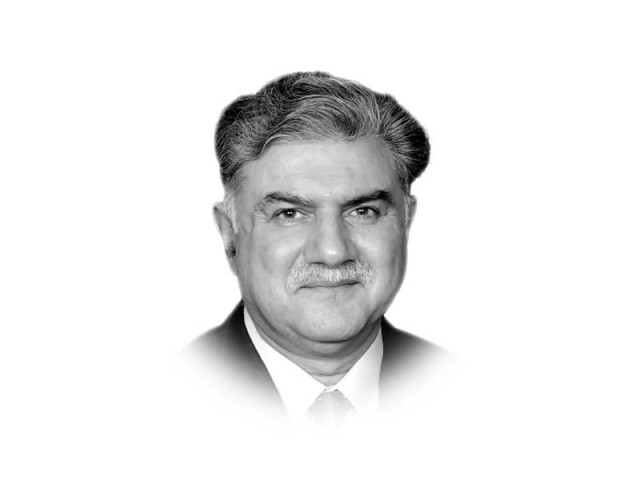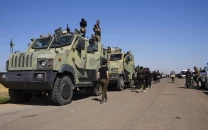Afghanistan Papers: counter-narcotics and counterinsurgency
In the long list of US/NATO failures, counter-narcotics and counterinsurgency strategies never complemented each other

This is last in a series of columns derived from the “Afghanistan Papers”, published in The Washington Post in December 2019, detailing causes of US failures in Afghanistan. The Afghanistan Papers were compiled from US Special Inspector General for Afghanistan Reconstruction (SIGAR) interviews of over 400 — mainly insider — US, Afghan and UN officials. The previous four columns outlined strategic (mis)direction of Afghan war, response to Pakistan-specific accusations, corruption under US watch and the raising of Afghan security forces. This column would detail the US war on drugs.
It was late 2017, when the US launched Operation IRON TEMPEST with massive aerial strikes to target clandestine opium production labs that ostensibly generated $200 million annually in drug money for the Taliban war economy, mainly by taxing farmers and traffickers. Air Force Brig Gen Lance Bunch pronounced with a swagger, “This is a new war, and the gloves are off.” Within 12 months, after over 200 airstrikes using advanced aircraft and laser-guided munitions, the Operation ran out of steam; as most suspected labs were empty, mud-walled compounds. The US/NATO war on drugs has repeatedly hit snags like the overall war effort, costing a whopping $9 billion since 2001 alone.
A former Afghan cabinet minister, Mohammed Ehsan Zia, attributed an inconsistent strategy, constantly changing policies and reliance on an army of expensive consultants, unschooled in Afghan environment for this failure. “Foreigners read ‘Kite Runner’ on [the] plane and believe they are an expert on Afghanistan and then never listen.” He lamented.
Despite efforts, Afghan opium production skyrocketed to over four times, accounting for 82% of the world’s supply during the 18-year war. The boom in drug related businesses seeped into the Afghan economy. It corrupted Afghan officials affecting governance and provided Taliban with stable revenue.
At the operational level, the US and UK tried bribing farmers; hiring mercenaries to destroy poppy fields; and urged spraying defoliants… to no visible effect. The operation was led by the State Department and Drug Enforcement Agency (DEA) with military remaining inconsistently involved in these opium wars. Generals during George W Bush’s administration (2001-2009), avoided involvement seeing it as a distraction from fighting terrorism. During Obama years (2009-2017), generals began to realise opium as a military threat. However, aggressive action would alienate poppy farmers — a large segment of Afghan population — besides US-aligned warlords who profited from opium trafficking.
Bureaucratic infighting is also blamed for many problems; “There was violent competition in Washington not only within Congress, between the Hill and the administration but also between different parts of the administration,” a US official told SIGAR interviewers in May 2016. The push and pull between the State Department’s Bureau of International Narcotics and Law Enforcement Affairs (INL) and Pentagon resulted in bureaucratic dysfunction.
Poppy cultivation remains cultural to Afghanistan since generations, especially in the insurgency-hit southern provinces of Helmand and Kandahar. Afghan opium resin once harvested is processed into morphine and heroin in drug labs and shipped to Europe, Iran and elsewhere in Asia.
Ironically, it was the Taliban who crippled the Afghan drug industry, when Mullah Mohammad Omar, the Taliban leader, outlawed growing poppies and opium production as un-Islamic in July 2000. Consequently, poppy cultivation dropped by 90% during 2000-2001. The Taliban edict elicited envy.
Afghan farmers resumed sowing poppy after the US military toppled the Taliban in 2001. In spring 2002, British officials — keen on performance — offered to pay Afghan poppy farmers $700 an acre to destroy their crops. This $30 million programme resulted in poppy-growing frenzy, with farmers offering part of their produce to the British and selling the rest in the open market. This programme expectedly failed as Afghans cunningly duped the authorities given their transient presence. The cultivation spikes in subsequent years, after the money dried up, resulted in over production of drugs.
French defense minister Michèle Alliot-Marie in as early as 2001 alerted US officials about the opium trade getting out of control, urging action “to avoid having a situation where drug money elects the Afghan Parliament.” The then-US ambassador, Ronald Neumann, in September 2005, warned his government about the narcotics sector spinning Afghan corruption out of control and “… strangle the legitimate Afghan state in its cradle” with the sheer mass of illegal money. The Bush administration failed to chalk an agreeable course of action. Destroying poppies, alienating poor farmers, winning hearts and minds, and providing alternative income remained elusive contradictory goals. Meanwhile the Taliban benefited from this catch-22 situation. Narcotics were fueling their insurgency.
Initial unwillingness to deal with narcotics, resulted in a situation where the US/NATO were unable to deal with it. When prodded by Congress in 2004 the INL hired some 1,200 security contractors to eradicate poppy. This small army included South African mercenaries, veterans of Balkan wars and Gurkha soldiers from Nepal, as per Ronald McMullen, INL director for Afghanistan-Pakistan (2006 to 2007). In systematic over-reporting during 2005 to 2007, the US, British and UN officials would exaggerate by reporting more poppy destroyed than was actually done, to show performance.
Many US lawmakers and Bush administration officials favoured an aggressive approach like “Plan Colombia”, where cancer-causing herbicides were aerially sprayed in Colombia to combat cocaine production. Afghan president Karzai, the British and some Bush administration officials opposed and ultimately rejected aerial spraying. This proposal made Karzai more suspicious of US motives.
Flawed eradication programmes, driven by Congress as late as 2015 missed the fact that successful counter-narcotics effort depended upon “... massive rural development effort.” In a major policy shift, Richard Holbrooke — after appointment as the State Department’s special representative for Afghanistan and Pakistan in 2009 — brought eradication to a standstill, shifting the US focus “to programmes that tried to persuade Afghan poppy farmers to switch to other crops or adopt other livelihoods.”
Even these efforts backfired. In Helmand, amidst the poppy belt, funding for digging and lining water channels to improve irrigation not only benefited fruit orchards; but irrigated poppies also, lucrative for being more profitable. In Helmand, USAID enticed farmers to grow wheat. It did increase wheat production, but farmers relocated poppy fields to other areas; resultantly between 2010-2014, poppy cultivation across the country almost doubled.
Some US officials attributed eradication failure to a fundamental misunderstanding of Afghanistan as an agricultural country and opium just another crop. Barnett Rubin, an academician and senior adviser to Holbrooke is quoted; “the largest industry [in Afghanistan] is war, then drugs then services. Agriculture is down in fourth or fifth place.” US military commanders were relieved once the Obama administration abandoned eradication programmes that they thought were pushing rural Afghans towards the Taliban.
When the generals wanted to wed their law enforcement, drug interdiction and economic development programmes with their counterinsurgency strategy, they “never received clear marching orders from the Obama administration” as there was no civilian counter-narcotics strategy.
In the long list of US/NATO failures in Afghanistan, counter-narcotics and counterinsurgency strategies never complemented each other, resulting in corruption and drug proliferation. Afghanistan is left to suffer the consequences.
Published in The Express Tribune, August 20th, 2020.
Like Opinion & Editorial on Facebook, follow @ETOpEd on Twitter to receive all updates on all our daily pieces.













COMMENTS
Comments are moderated and generally will be posted if they are on-topic and not abusive.
For more information, please see our Comments FAQ